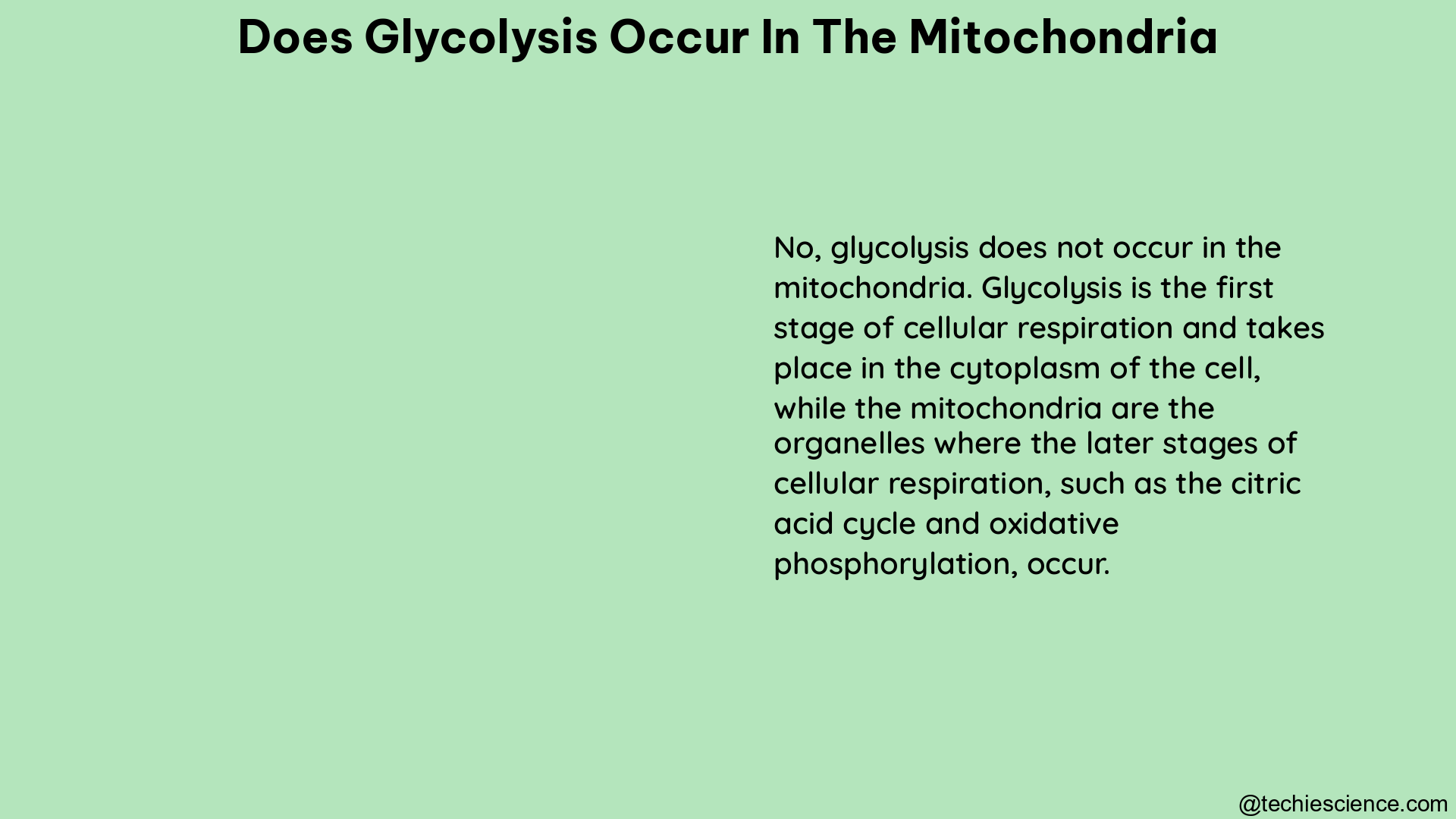Glycolysis is a fundamental metabolic pathway that occurs in the cytoplasm of cells, where it breaks down glucose into two molecules of pyruvate, producing a net gain of two ATP molecules and two NADH molecules. However, recent studies have revealed that some eukaryotic organisms, particularly within the stramenopiles group, exhibit a unique form of glycolysis that takes place partially within the mitochondria.
Glycolysis: The Cytoplasmic Pathway
Glycolysis is a series of enzymatic reactions that convert glucose, a six-carbon sugar, into two molecules of pyruvate, a three-carbon compound. This process occurs in the cytoplasm of cells and is the first step in cellular respiration, which ultimately leads to the production of ATP, the primary energy currency of the cell.
The glycolytic pathway can be divided into two phases:
- Preparatory Phase: During this phase, glucose is phosphorylated and then split into two three-carbon molecules called glyceraldehyde-3-phosphate (G3P).
- Pay-off Phase: In this phase, the G3P molecules are further metabolized, resulting in the production of two ATP molecules and two NADH molecules.
The enzymes involved in glycolysis are located in the cytoplasm, and the entire process takes place outside the mitochondria.
Mitochondrial Glycolysis: A Unique Adaptation

While glycolysis is typically confined to the cytoplasm, recent studies have revealed that some eukaryotic organisms, particularly within the stramenopiles group, have evolved a unique adaptation where the latter half of the glycolytic pathway occurs within the mitochondria.
Stramenopiles and Mitochondrial Glycolysis
The stramenopiles are a diverse group of eukaryotes that include various photosynthetic and heterotrophic organisms, such as diatoms, brown algae, and the human pathogen Blastocystis. Interestingly, all tested stramenopiles, with the exception of Blastocystis, exhibit evidence of the second half of glycolysis taking place in both the mitochondria and the cytosol.
In the case of Blastocystis, the entire second half of glycolysis occurs exclusively within the mitochondria. This suggests that mitochondrial glycolysis is a common feature among the stramenopiles, despite the considerable metabolic and physiological diversity within this group.
Evolutionary Implications
The discovery of mitochondrial glycolysis in stramenopiles raises intriguing questions about the evolutionary history of this metabolic pathway. The deep branches of the eukaryotic tree are not yet fully resolved, but there is substantial phylogenomic support for the grouping of stramenopiles with alveolates and rhizarians to form the “SAR” supergroup.
Interestingly, predicted mitochondrial targeting has been reported for several glycolytic enzymes, including TPI-GAPDH fusion proteins, in members of the cercozoa, a group of rhizarians, and the distantly related apusozoan Thecamonas trahens also encodes a TPI-GAPDH fusion protein. These findings suggest that the latter steps of glycolysis may have occurred in the mitochondria of the SAR common ancestor.
Metabolic Flexibility and Adaptation
The presence of mitochondrial glycolysis in stramenopiles and potentially other eukaryotic lineages highlights the remarkable metabolic flexibility and adaptability of these organisms. The intracellular distribution of even the most fundamental metabolic pathways, such as glycolysis, can vary significantly between different groups of eukaryotes.
This variability may be driven by a range of factors, including environmental conditions, energy demands, and evolutionary pressures. By compartmentalizing glycolysis between the cytoplasm and the mitochondria, stramenopiles and other eukaryotes may be able to optimize their energy production and metabolic efficiency in response to their specific ecological niches and physiological requirements.
Conclusion
While glycolysis is typically considered a cytoplasmic process, the discovery of mitochondrial glycolysis in stramenopiles and potentially other eukaryotic lineages underscores the remarkable diversity and adaptability of metabolic pathways within the eukaryotic domain. This finding challenges the traditional view of glycolysis and highlights the need for a more nuanced understanding of the intracellular distribution and evolution of even the most fundamental metabolic processes.
As our knowledge of eukaryotic metabolism continues to expand, further research into the mechanisms, evolutionary origins, and functional implications of mitochondrial glycolysis will undoubtedly yield valuable insights into the remarkable complexity and versatility of cellular metabolism.
References:
- Quizlet. (n.d.). Where does glycolysis take place? A. mitochondrion B. cytoplasm C. cell membrane D. 28fbccbe-b80e-48b4-b97c-63564f9f8a93. Retrieved from https://quizlet.com/explanations/questions/answer-the-questions-where-does-glycolysis-take-place-a-mitochondrion-b-cytoplasm-c-cell-membrane-d-28fbccbe-b80e-48b4-b97c-63564f9f8a93
- BYJU’S. (n.d.). Does glycolysis take place in the mitochondria? Retrieved from https://byjus.com/question-answer/does-glycolysis-occur-in-the-mitochondria/
- Nature. (n.d.). Metabolism in a eukaryotic cell: Glycolysis, the citric acid cycle, and oxidative phosphorylation. Retrieved from https://www.nature.com/scitable/content/metabolism-in-a-eukaryotic-cell-glycolysis-the-14705577/
- Academic.oup.com. (2018, July 30). Mitochondrial Glycolysis in a Major Lineage of Eukaryotes. Retrieved from https://academic.oup.com/gbe/article/10/9/2310/5061552
- Ncbi.nlm.nih.gov. (2018, July 30). Mitochondrial Glycolysis in a Major Lineage of Eukaryotes – PMC. Retrieved from https://www.ncbi.nlm.nih.gov/pmc/articles/PMC6198282/

Hello, I am Sugaprabha Prasath, a Postgraduate in the field of Microbiology. I am an active member of the Indian association of applied microbiology (IAAM). I have research experience in preclinical (Zebrafish), bacterial enzymology, and nanotechnology. I have published 2 research articles in an International journal and a few more are yet to be published, 2 sequences were submitted to NCBI-GENBANK. I am good at clearly explaining the concepts in biology at both basic and advanced levels. My area of specialization is biotechnology, microbiology, enzymology, molecular biology, and pharmacovigilance. Apart from academics, I love gardening and being with plants and animals.
My LinkedIn profile-